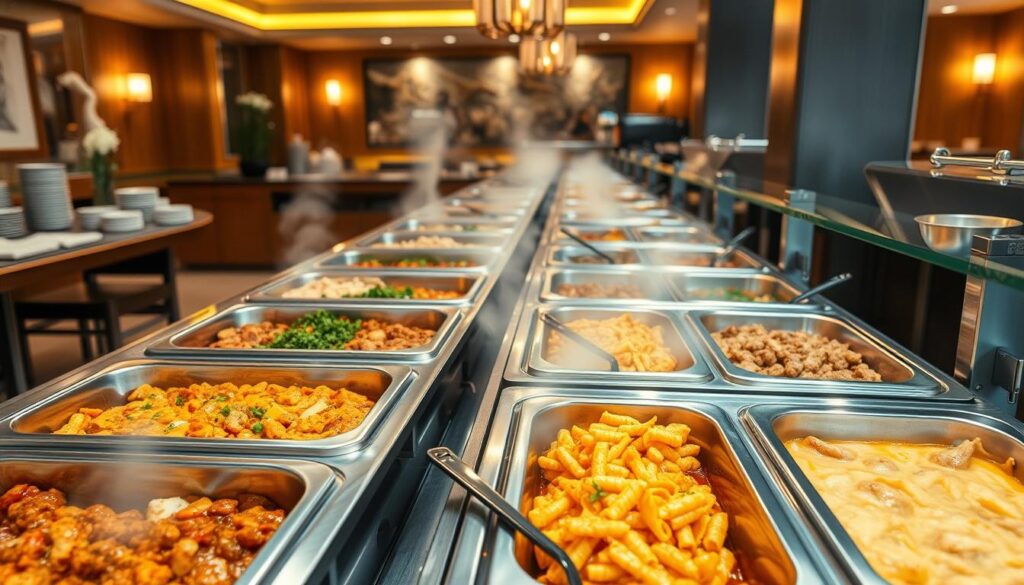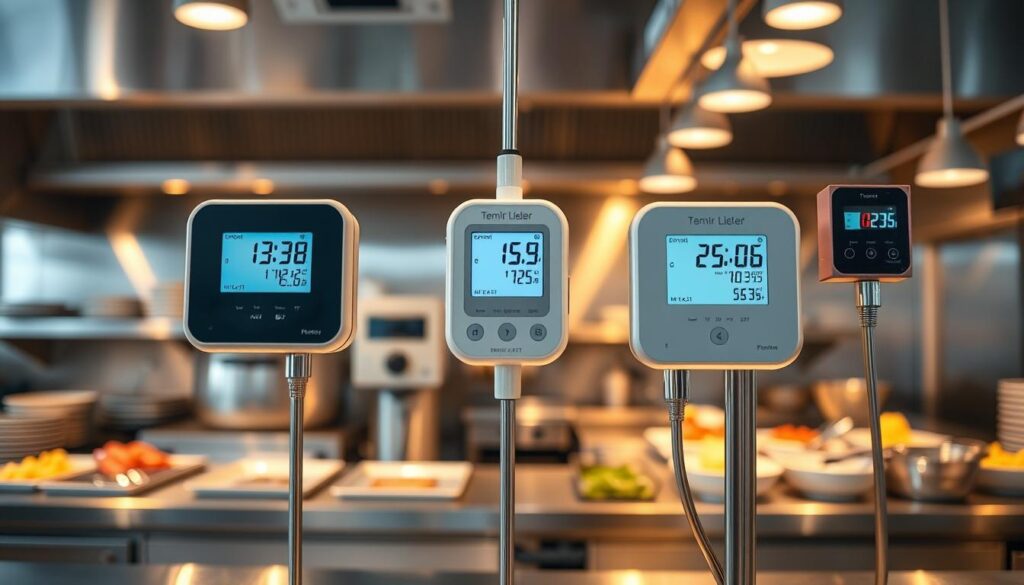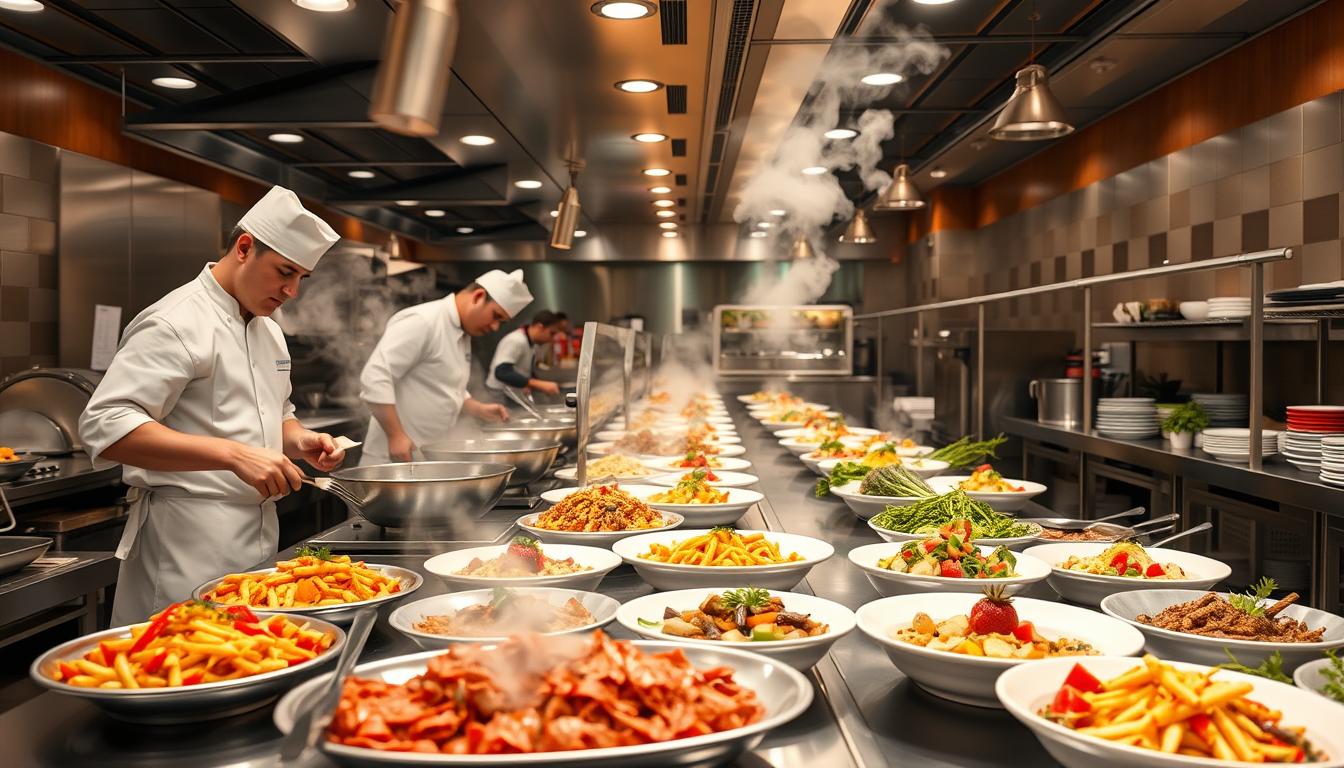Managing hot food lines is key for restaurants. They need to keep food at the right temperature. This ensures food is safe and customers are happy.
Restaurants today face big challenges in keeping food at the right temperature. Every year, 48 million people in the US get sick from food. And 60% of these cases happen in restaurants. So, knowing how to manage hot food lines is very important.
To do well, restaurants need the right equipment and to check temperatures often. They also need to train their staff well. Using steam tables and keeping food at the right temperature helps keep everyone safe and food tasty.
Key Takeaways
- Hot food must be consistently maintained above 135°F to meet safety guidelines
- Strategic equipment selection enhances food service efficiency
- Temperature monitoring prevents potential foodborne illness risks
- Staff training is essential for maintaining food safety standards
- Different steam table configurations suit various restaurant needs
Understanding Food Temperature Safety Fundamentals
Food safety is very important in restaurants. It helps stop foodborne illnesses. Every year, about 48 million Americans get sick from food.
To stop bacteria, we must know about temperature. Restaurants need to keep food at safe temperatures. This helps avoid health problems.
Essential Temperature Ranges for Food Safety
- Cold foods must be kept at or below 40°F
- Hot foods should be maintained above 140°F
- Reheated foods require an internal temperature of 165°F
Temperature Danger Zones to Avoid
The danger zone is between 40°F and 140°F. Bacteria grow fast here. Knowing this zone helps stop food contamination.
| Food Type | Safe Cooking Temperature |
|---|---|
| Beef, Pork, Veal, Lamb | 145°F with 3-minute rest |
| Ground Meat | 160°F |
| Poultry | 165°F |
| Fish | 145°F |
Proper Storage and Holding Requirements
Hot foods must stay above 140°F. This stops bacteria. Foods that can spoil should not stay in danger zones for more than two hours. This time is one hour if it’s over 90°F.
Proper temperature control is not just a recommendation—it’s a critical safety measure that protects both customers and restaurant reputation.
Setting Up Hot Food Lines and Steam Table Equipment
Creating a good hot food line needs careful planning and the right tools. Steam tables are key for keeping food warm and safe. They help restaurants keep many dishes at the right temperature.

- How many compartments you need
- Whether to use gas or electric
- How much space you have
- What kinds of dishes you’ll serve
Gas steam tables heat up fast and save money on bills. They’re great for places that serve a lot of food. Electric ones take longer to warm up but control temperature better.
| Steam Table Type | Key Features | Best For |
|---|---|---|
| Open-Well | Needs spillage pans | Best for moist foods |
| Sealed-Well | No extra pans needed | Easy food holding |
| Mobile | Has casters | Good for events and changing setups |
Important extras like adapter plates, sneeze guards, and overshelves help keep food warm. Stainless steel makes them strong and easy to clean. These are good choices for kitchens.
It’s important to keep food at 135 degrees Fahrenheit or higher for safety and taste.
Implementing Temperature Monitoring Systems
Keeping food safe is key in restaurant kitchens. With the right tools, restaurants can keep food quality high. This also protects customers.
Temperature Monitoring Tools and Equipment
Today’s kitchens use smart digital thermometers for temperature control. The main tools are:
- Digital probe thermometers for quick food temperature checks
- Infrared thermometers for fast surface checks
- Wireless systems like E-Control Systems’ IntelliSense™ technology

Digital Recording and Logging Procedures
Digital logging makes tracking temperatures easy. It offers real-time updates and keeps records forever.
“Accurate temperature logs are the backbone of food safety protocols in professional kitchens.”
Staff Training for Temperature Checks
Training staff is vital for good temperature checks. Important parts of training are:
- Learning how to use digital thermometers
- Knowing safe temperature ranges
- Spotting and fixing temperature issues
- Keeping accurate records
Restaurants need to make food safety a team effort. Every staff member must know how important temperature monitoring is.
Conclusion
Managing a hot food line well is key to a restaurant’s success. It helps keep food safe and makes customers happy. By controlling temperatures and choosing the right equipment, a kitchen becomes a precise place.
Restaurant owners need to see food safety as more than just rules. They should pick the right tools like heat lamps and strip warmers for keeping food at the right temperature. These tools help avoid sickness and keep food quality up.
Investing in good temperature tracking systems is smart. Modern restaurants focus on safety and reliability, not just speed. They use digital tracking, train staff well, and use top-notch warming equipment. This cuts down waste, lowers health risks, and boosts kitchen performance.
Good hot food line management is all about a big picture view. It needs constant staff training, equipment upkeep, and a drive for excellence. Restaurants that focus on these will meet rules and stand out for quality, safety, and professionalism.
FAQ
What is the “danger zone” for food temperatures?
The danger zone is between 40°F and 140°F. Bacteria grow fast here. Foods left in this range for over 2 hours can be unsafe.
How often should I check food temperatures in a hot food line?
Check food temperatures every 2 hours. This is key for keeping food safe. Check at the start, during, and before moving food.
What type of steam table is best for my restaurant?
The right steam table depends on your needs. Gas models save energy for long use. Electric ones are easier to install and control temperature better.
What temperature should hot foods be held at?
Hot foods need to stay at 140°F or above. This stops bacteria from growing. It also keeps food warm and tasty.
What equipment is essential for temperature monitoring?
You need digital probe thermometers, infrared thermometers, and steam tables with displays. Make sure these tools are always right.
How can digital logging systems improve food safety?
Digital logging systems watch temperatures in real time. They send alerts and keep records. This helps restaurants stay safe and ready for health checks.
What should I do if food falls into the danger zone?
If food is between 40°F and 140°F for over 2 hours, throw it away. Then, reheat it to 165°F or cool it down right.
How often should staff be trained on temperature monitoring?
Staff needs training at the start and every year. New hires get training right away. Keep learning part of regular meetings.

